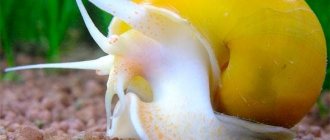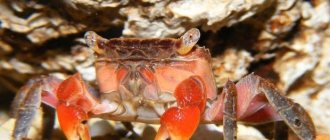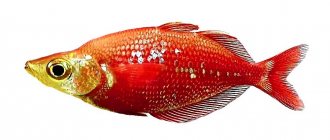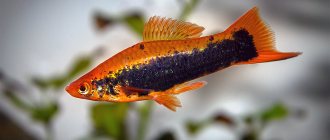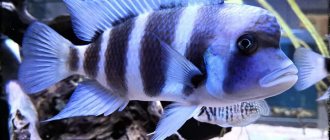5
(8)
Modern underwater fauna is represented in a wide variety. It is not surprising, because the oceans occupy most of our planet, and in its waters live many animals that, on their evolutionary path, have adapted to their habitat, and therefore have their own specific appearance, character and other distinctive features.
We can especially notice this in pet stores, where many different fish swim. Some aquarists prefer to have more species-specific aquariums, perhaps with large representatives such as angelfish, goldfish, pterygoplichths, labeo, synodontis, etc. Others try to have the most diverse home pond, arranging there a kind of “hodgepodge” of small and active individuals. The aquarium fish Rasbora is one of these.
Description of the species
The aquarium fish Rasbora belongs to the carp family. In its natural habitat, the phenotype lives in small rivers and lakes in India, Southeast Asia, and Indonesia, trying to stay close to the surface of the water. Prefers soft water with dense thickets of vegetation, and dim lighting. The wedge-spotted rasbora is a schooling fish; in nature it lives in small groups of 10–15 individuals, so a schooling phenotype is recommended in an artificial reservoir.
Description of appearance:
- the body is slender, slightly laterally compressed;
- the caudal fin is forked at the end.
Such features are characteristic of most varieties, however, some rasbor species are distinguished by a shorter and taller body with large scales.
Breeding
In favorable conditions, the fish will give birth quite often. However, in a community aquarium environment, juveniles rarely grow to adulthood. The thing is that Rasbor has no parental instincts. Immediately after the end of spawning, they eat the eggs and the emerging fry, and those that can survive will begin to experience a lack of food. To preserve eggs, a separate spawning aquarium is usually used, where the young are completely safe. But the problem of providing suitable products remains - microscopic powdered food is required, purchased separately.
Shiny Rasbora
The brilliant Rasbora, scientific name Rasbora einthovenii, belongs to the family Cyprinidae
Dwarf rasbora
The dwarf rasbora, scientific name Boraras maculatus, belongs to the family Cyprinidae
Cottelata Brittany
Kottelatia brittani, scientific name Kottelatia brittani, belongs to the family Cyprinidae
Red-nosed Rasbora
Red-nosed Rasbora or Sawbwa, scientific name Sawbwa resplendens, belongs to the family Cyprinidae
Red-striped Rasbora
Red-banded Rasbora, scientific name Trigonopoma pauciperforatum, belongs to the family Cyprinidae
Red-tailed Rasbora
Red-tailed or Black-striped Rasbora, scientific name Rasbora borapetensis, belongs to the family Cyprinidae
Fire Rasbora
Fire Rasbora, scientific name Rasboroides vaterifloris, belongs to the family Cyprinidae
Striped Rasbora
Striped Rasbora or Indian Rasbora, scientific name Rasbora daniconius, belongs to the family Cyprinidae
Rasbora Harlequin
Rasbora Harlequin, scientific name Trigonostigma heteromorpha, belongs to the family Cyprinidae
Brigid's Rasbora
Brigitte's rasbora, scientific name Boraras brigittae, belongs to the family Cyprinidae
Rasbora Dorsinotata
Rasbora dorsinotata, scientific name Rasbora dorsinotata, belongs to the family Cyprinidae
Rasbora Duson
Rasbora duson, scientific name Rasbora dusonensis, belongs to the family Cyprinidae
Rasbora is tiny
Tiny rasbora, scientific name Boraras micros, belongs to the family Cyprinidae
Rasbora Merah
Rasbora Merah, scientific name Boraras merah, belongs to the family Cyprinidae
Rasbora Nevus
Rasbora Nevus or Strawberry Rasbora, scientific name Boraras naevus, belongs to the family Cyprinidae
Rasbora pied-tailed
The variegated rasbora, scientific name Rasbora caudimaculata, belongs to the family Cyprinidae
Rasbora spotted back
Rasbora dorsiocellata, scientific name Brevibora dorsiocellata, belongs to the family Cyprinidae
Rasbora Firefly
Rasbora firefly, scientific name Boraras urophthalmoides, belongs to the family Cyprinidae
Rasbora somphongsi
Rasbora somphongsi, scientific name Trigonostigma somphongsi, belongs to the family Cyprinidae
Rasbora is slim
Rasbora slender, scientific name Trigonopoma gracile, belongs to the family Cyprinidae
Rasbora Tornieri
Rasbora tornieri, scientific name Rasbora tornieri, belongs to the family Cyprinidae
Rasbora Hengel
Luminous Rasbora or Hengel's Rasbora, scientific name Trigonostigma hengeli, belongs to the family Cyprinidae
Rasbora Chiya
Rasbora cheeya, scientific name Brevibora cheeya, belongs to the family Cyprinidae
Rasbora espes
Rasbora espes or False rasbora harlequin, scientific name Trigonostigma espei, belongs to the family Cyprinidae
Three-linear Rasbora
Trilinear Rasbora, scientific name Rasbora trilineata, belongs to the family Cyprinidae
Elegant Rasbora
Elegant Rasbora, scientific name Rasbora elegans, belongs to the family Cyprinidae
Rasbora the Clown
Clown Rasbora, scientific name Rasbora kalochroma, belongs to the family Cyprinidae (Cyprinidae)
Simple rasbora
Rasbora simple, scientific name Rasbora rasbora, belongs to the family Cyprinidae (Cyprinidae)
Ezomus fish
The Esomus fish, scientific name Esomus thermoicos, belongs to the family Cyprinidae (Cyprinidae)
Reticular Rasbora
Reticulated Rasbora, scientific name Rasbora reticulata, belongs to the family Cyprinidae (cyprinidae)
Rasbora volcano
Rasbora volcano, scientific name Rasbora vulcanus, belongs to the family Cyprinidae (Cyprinidae)
Rasbora two-lane
Rasbora cephalotaenia, scientific name Rasbora cephalotaenia, belongs to the family Cyprinidae (Cyprinidae)
Rasbora Baboon
Rasbora Baboon, scientific name Rasbora paviana, belongs to the family Cyprinidae (Cyprinidae)
Varieties of analysis
Aquarium fish are divided into many varieties based on body shape, size and color characteristics. The favorites remain the galaxy rasbora and the cuneiform rasbora. However, there are other, no less interesting and attractive representatives of these charming fish.
Decorative varieties:
- Rasbora galaxy is a small fish 2–3.5 cm long. The color of the variety is bright, with a lot of color, the fins are painted in a scarlet shade. Rasbora galaxia was recently identified, and, according to scientists, the species is more likely to be a zebrafish.
- Rasbora wedge-spotted - the fish is also called heteromorph or rasbora harlequin. The length of the representatives reaches 4–5 cm, the color of the scales is silver or gold. A distinctive feature is a dark spot on the body, shaped like a wedge.
- Brigitte - the variety is distinguished by its miniature size: only 1.5 - 2 cm. Males have a scarlet color, females are pink-yellow. There is a bright light green stripe on the body.
- Hengel's wedge-shaped rasbora is distinguished by a neon stripe on the body, which mysteriously flickers and shimmers.
- Ribbon fish - distinguished by a wide range of scales: blue, gray, cream or light blue.
- Dwarf rasbora (kubotai) is a peace-loving tiny fish with a modest color.
Microassortment galaxy
This species has been known in Europe since 2006. It belongs to the genus Danio.
In their natural environment, these fish love to live in thickets of aquatic plants. They have white spots on their body that look like pearls. Males are blue-gray with a bright red belly, while females are gray-black. The belly of females is yellowish. The fish have black and red stripes on their fins.
Length maximum 3 cm.
Microassembly galaxy is suitable for nanoaquariums from 30 l. You should not purchase a large tank for them. There should be 10-20 individuals in the flock. Plants are a must, because without them, pets become shy and their color begins to fade. Males that do not have a dominant role will be able to hide in green shelters. The water in the aquarium must be clean and transparent, so a filter and an aerator are required when maintaining it. The current should not be strong.
Life expectancy is about 2 years.
Keeping in an aquarium
Keeping and caring for rasboras in an aquarium will not cause much trouble even for a novice aquarist. The fish, despite its miniature size, loves space and being kept in schools, so the volume of the tank should be at least 50 liters of water for a group of 10–15 individuals. The artificial pond is equipped with a lid or mesh on top to prevent moving pets from leaving the water space.
Water indicators in the aquarium:
- hardness – 4–15 dH;
- acidity – 6 – 7.5 pH;
- temperature – 25C.
The green-eyed rasbora comes from countries with a mild, warm climate, so low temperatures in the aquatic environment will kill the pet. In winter, experienced aquarists recommend acquiring a heater and thermometer to control the temperature.
If you plan to breed cuneiform rasbora in an artificial reservoir, then you cannot do without a filter. Mechanical filtration is installed in the aquarium, and the water is renewed weekly, replacing 30% of the volume.
The rasbora aquarium fish prefers dim lighting, even slightly darkened. At home, the phenotype lives in rivers and lakes, where sunlight is obscured by dense tree crowns - hence the fish’s love for dim light. The soil is chosen in a dark color, and the vegetation is planted in a dense layer. Decorations must be placed in the tank: shelters, grottoes and caves, since the species are shy and cautious. An algae-free area is left for feeding and swimming.
Care and maintenance
Rasboras are unpretentious fish; they quickly adapt to new conditions. However, they can be kept in small aquariums with a volume of at least 40 liters. It is advisable that there is a hiding place in the aquarium, as these small inhabitants love to hide.
A broken clay jug, driftwood or plants can serve as a shelter for them. If the aquarium is small, then you should not plant too many plants, as the fish should have enough space to swim freely.
The comfortable water temperature for them is +25 °C. Aquatic inhabitants love diffused light, so it is undesirable for direct sunlight to enter the aquarium. To do this, you can put various floating plants on the water.
Keeping the cuneiform rasbora does not pose any particular difficulties, and that is why it is often started by novice lovers of the aquatic world. Rasbora heteromorph gets along well with all peaceful fish.
There are a number of nuances when caring for this fish.
The following aquatic inhabitants are suitable for it:
- barbs;
- neons;
- guppy;
- discus;
- minors;
- tetras;
- platies;
- battles;
- iris.
But rasbora cannot be kept with cichlids, goldfish and astronotuses, since these species will perceive it exclusively as food.
It is important to remember that these fish are quite active and can jump out of the water, so they should only be kept in a closed aquarium.
To keep the water clean, you should install a special filter. Rasboras emit few waste products , so you can use a filter that is not the most powerful. You should also not forget about changing the water - it is advisable to do this at least once a week.
Feeding
By nature, many species of rasboras are predatory fish, and in the wild they happily feast on insects, plankton, worms and larvae. In aquarium conditions, pets are not picky and happily eat dry, frozen and live food. The main thing is that the fish’s diet is balanced and varied, so aquarists feed their pets with the following products:
- plant food;
- mosquito larvae;
- Artemia and Daphnia;
- Cyclops;
- bloodworm;
- dry granulated food.
An interesting fact: fish prefer to eat alone, so when food gets inside the reservoir, each individual actively grabs its dinner or lunch and moves into the depths of the water space.
What to feed
By nature, these fish are predators. Therefore, live food (worms, insects, larvae) is suitable for feeding them. Frozen or dry food will also be to the taste of the fish. From plant foods, you can give your pets dandelions, white bread, oatmeal, semolina and lettuce leaves treated with hot water. About once a week you can feed the fish with low-fat cottage cheese, grated cheese, tubifex or bloodworms. They should not be included in the diet more often, so as not to cause obesity in the fish.
For frozen food, Rasboras need to buy daphnia, bloodworms, coretra and brine shrimp. Such food improves the activity of pets and gives their color a more intense color.
When feeding, you need to sprinkle food in small portions. Otherwise, the food will settle to the bottom where the fish will not be able to reach it. Due to the large amount of rotted food debris, the water in the aquarium will quickly deteriorate. In addition, the food needs to be chopped well. The fish will not be able to swallow large pieces of food.
The diet of these fish should be varied and balanced. This is the main requirement for their nutrition.
Compatibility
It is worth noting right away that one or two fish cannot be kept in an aquarium. Rasboras are pack animals, so without their relatives they wither and get sick. Thanks to its peaceful and calm nature, the phenotype easily gets along with tetras, zebrafish and other friendly species. It is easier to list those phenotypes with which rasbors are not compatible. These are predatory and aggressive fish, such as:
- astronotuses;
- cichlids;
- Japanese koi carp;
- discus aquarium fish.
Reviews
Aquarists confirm that the wedge-shaped rasbora looks impressive in the aquarium. Experience in solitary housing indicates the need for a school: the fish becomes aggressive and restless. Difficulties are noted with breeding and determining the sex of fish. There is ongoing debate among aquarists about the correct conditions for spawning.
Reproduction
You can breed fish only if you have knowledge about the intricacies and nuances of this process. Pets reach sexual maturity at 10–11 months, and only after this age is it possible to reproduce at home.
Two weeks before spawning, females and males are separated and placed in different containers. The ratio of male to female sex in the spawning tank should be 2:1, and it is advisable to choose males older than females.
Then the spawning tank is prepared. A separate container with a volume of 20–30 liters is filled with peat water (melt or distilled) with suitable indicators; underwater flora with wide leaves, for example, cryptocoryne, is also planted in the nursery. The height of the water level is 20–25 cm, and after dissolving the peat, the water should be greenish or tea-colored. If you wish, you can make a fish tank with your own hands in a common aquarium.
After a group of fish settles into the aquarium, reproduction occurs in approximately 2–3 days. During this period, pets are not fed to prevent contamination of the aquatic environment. Spawning occurs in dense algae and takes one or two hours. During this time, the female lays about two hundred eggs, after which the parents are returned back to the tank so that the fish do not eat the offspring.
The fry are born after the fifth day, and two days later they are already vigorously swimming in the pond. At this time, aquarists begin to feed the young animals with small food, cyclops, yolk and ciliates. Before moving into a common reservoir, the fry are accustomed to future water parameters, gradually increasing the hardness in the tank.
Genus Rasbora – Real Analysis
The central, largest genus of the subfamily, numbering more than 50 species, which most likely is the result of shortcomings of taxonomists who have not yet understood all the intricacies of family relationships in this complex and still insufficiently studied group of fish. Probably, in the future we will have a more detailed classification. The composition includes fish of similar shape with an elongated low body, a predominance of silver tones in color and often a pronounced pattern of longitudinal dark stripes or individual large spots.
R. red-tailed
R. red-tailed
R. redtail (Rasbora Borapetensis)
The body of R. red-tailed is elongated in length and compressed at the sides. The mouth is terminal, large eyes. The color of the back is olive, the belly is white, the sides are greenish-yellow, tinged with silver. The scales on the body of R. red-tailed form a beautiful mesh pattern. A black stripe runs through the entire body from the gills to the tail, with a golden stripe just above it. There is a black stripe near the anal fin at the very base. The fin on the back and tail have a reddish color at the base. The color of the tail itself is red in adults; in juveniles it is transparent. The male is distinguished by its smaller size, slender body and bright color. Length up to 5 cm. Lives about 4 years. The conditions of detention are the same as for everyone. 23-25°C, hardness 4-12°, acidity 6.0-7.2. Filtration, aeration, water change. Breeding . Just like others. Nuances . They ripen at 8-10 months. Temperature 25-28°C, hardness no more than 10°, acidity 6.0-7.5. Water level 15-20 cm. Lighting is moderate. The female's productivity is 30-40 eggs.
R. Piedtail
R. Caudimaculata
They are a close relative of R. Trilineata, with which it is combined into the group of so-called R. scissortails . They are characterized by a deep notch of the caudal fin and contrasting signal spots on its blades. During movement, these blades are folded and unfolded like scissors. These are fast swimmers who often jump out of the water, so the tank with them must be kept tightly closed. In R. pied-tailed, the caudal lobes are colored in reddish tones and have black spots at the ends. The body is silvery with a blurred dark longitudinal stripe on the side. The dorsal fin is slightly pinkish in males. Length up to 12 cm. Range: Malay Peninsula, Sumatra, Kalimantan.
R. Two-lane
R. Two-Stripe (R. Cephalotaenia)
They belong to the extensive group of R. with a longitudinal dark stripe, but they differ well from others in that this stripe is not continuous, but is, as it were, composed of two parallel rows of dots, between which there is a light gap. The overall silver color has a pink tint, the fins have a yellowish tint. Large ones, up to 13 cm long, inhabit the reservoirs of the Malacca Peninsula, Sumatra and Kalimantan.
R. Einthoven
R. Einthovenii
A dark stripe on the body runs from the mouth through the eye and to the caudal fin. In males, the stripe is wider, the body is purple, and the dorsal fin is red. In females, a greenish tint predominates. Length up to 9 cm. The range covers southern Thailand, the Malacca Peninsula, Sumatra and Kalimantan.
R. three-spotted (R. Elegans)
Unlike most others, the pattern on the body does not consist of longitudinal stripes, but of spots. Usually, contrary to the name, only two dark spots are clearly visible - one in the middle part under the dorsal fin, and the second at the base of the tail. Only some forms have a third small spot at the anal fin. The body itself is greenish or pinkish-brown. One of the largest, some specimens reach a length of 20 cm, although usually no more than 15 cm. Distributed on the Malay Peninsula, Sumatra and Kalimantan.
R.-Clown
R. Clown (R. Kalochroma)
Like the previous ones, in general they have a spotted color that is uncharacteristic for large ones, but it looks completely different. A small round spot is located immediately behind the operculum, and a second, larger, usually quadrangular spot is located above the anal fin. In addition, R.-Clown looks much more elegant: her body is painted a bright pink-orange color, and her fins are lemon yellow. The dark edges of the scales form a slightly visible mesh pattern. Body length up to 10 cm. Distributed on the Malay Peninsula, Sumatra and Kalimantan.
R. Krasnospinnaya
R. redback (R. rubrodorsalis)
Very bright, attractive, but still rare in aquariums. It lives together with the very similar R. Borapetensis, both of which have red tails. However, they can be easily distinguished by their crimson-red dorsal fin and similarly colored caudal fin, while the Red Tail has a colorless dorsal fin and a paler red color present only at the base of the caudal fin. In addition, R. redback is smaller, rarely exceeding 3 cm. It is found in the Mekong basin in the northeastern regions of Thailand.
R. Three-linear
R. Trilineata
The most characteristic feature is the caudal fin. It is whitish with transverse wide dark stripes on the lobes and with a black horizontal stroke in the middle - a continuation of the narrow dark horizontal stripe on the body. Interestingly, this type of coloration is also found in other orders of fish, for example, in the group of South American Red-nosed Tetras. The long blades of the fin can close together like the blades of scissors as the fish moves. The body is silvery, the back is dark olive, the belly is silvery-whitish. In nature it grows up to 15 cm, in captivity up to 10 cm. They live in the lower Mekong basin, on the Malay Peninsula, Sumatra and Kalimantan.
R. Mesh
R. reticulated (R. Vulcanus)
R. Vulcanus - decorative aquarium fish, up to 4 cm in length, do not have any pronounced dark markings on the body, but they have a beautiful dark mesh pattern formed by the edging of the scales. Otherwise called R. Volcanic. There is a story that the Latin name “volcanic” arose due to the fact that they were first discovered at the foot of the active Taldang volcano in western Sumatra. However, most likely, this name was assigned to R. reticulate for the bright red color of the males. Very often they are incorrectly called R. reticulata. In fact, true Reticulata live only on the tiny island of Nias off the northwestern tip of Sumatra and are not supplied to the market.
- Cichlids of African lakes and rivers
- Aquariums: types and forms
Diseases
If the temperature and keeping conditions are observed, the fish rarely get sick. Common diseases include the following:
- Cold – occurs when the temperature in the aquarium drops significantly, and can be expressed as a fungus on the pet’s body. As a treatment, raise the temperature to 29C, and also increase the power of the aerator.
- Oodiniosis is caused by flagellated parasites. For treatment, salt is added to the water, or bicillin-5 is used.
- Changes in water parameters - with sudden changes in acidity and hardness, rasboras experience stress and shock, some pets die.
To avoid the development of parasites and diseases, pets are carefully looked after, monitoring water parameters, cleaning the aquarium and monitoring the quality of food.
Rasboras are aquarium fish whose unpretentiousness and variety of colors are loved by many aquarists. By following simple rules, you can admire the moving miniature pets for a long time, and also get cute and attractive offspring, increasing the number of inhabitants in the reservoir.
Rasbora Heteromorpha or Wedge-shaped (Trigonostigma heteromorpha)
Rasbora Heteromorpha (T. heteromorpha) representative of the genus, appearance.
A long-time favorite in home aquariums, its history dates back over a hundred years. For most aquarists, the name rasbora is associated with this species, although, as we already know, it is the most atypical representative of this group. This is the largest (up to 5 cm) and tall-bodied of all cuneiform rasboras. The body color is pinkish, a black wedge-shaped spot starting from the middle of the body, wide, evenly tapering towards the tail. In males it is clearly defined, in females it is blurred, with a rounded lower apex. In addition, males are distinguished by a brighter red dorsal fin. The species is widespread in Thailand, Malaysia, Sumatra and Kalimantan.
Rasbora Somphongsi (Trigonostigma somphongsi)
Rasbora Somphongsi (T. somphongsi) representative of the genus, appearance.
The smallest representative of the genus, reaching a length of only 3 cm, and at the same time characterized by the least tall, slender body. The spot only slightly widens in the front part and is rather a longitudinal stripe stretching from the base of the tail to the middle part of the body. Its front part is surrounded by a bright yellow edging, while the overall color tone is golden. The species is rare in nature and details of its distribution need to be clarified. It is reliably known to live in some western regions of Thailand.
Rasbora Somphongsi (T. somphongsi) is the smallest representative of the genus
Cuneiform Rasboras are an excellent choice for general and species aquariums and are widely found among aquarists around the world.
Reproduction and sexual characteristics of rasbora
These fish become mature enough to have offspring at about one year of age, in some cases a little earlier. When the time comes for spawning, to carry out the reproduction process, individuals of different sexes are placed for ten days in different containers. This is not difficult to do, because females during this period are quite easy to distinguish by their enlarged belly.
From the editor: Yellow platylia
In the photo there is rasbora eintovina
In the meantime, you can start setting up a spawning area. It should be spacious and have a volume of about 15 liters. The water level in it must be set at a height of up to 20 cm.
The bottom of the container is covered with a nylon mesh with a mesh size of no more than half a centimeter, so that accidentally falling eggs pass through the holes and are preserved without being eaten by adult fish.
Plant bushes should be placed in a number of places on the grid. This is an imitation of natural spawning conditions, where aquatic flora serves as the basis for holding eggs. Javanese small-leaved moss is best suited here, although some varieties of rasbor prefer fluffy types of flora.
The water for spawning should be two to three degrees warmer than usual, which serves as a signal for fish to reproduce. Also necessary, regardless of the time of day, is constant lighting and aeration.
In the photo there is a red line rasbora
The best option would be if, during mating games, there were up to six individuals together in a container, which should be covered with glass to prevent fish from jumping out: males and females in equal numbers.
Spawning for these fish usually begins in the morning and lasts up to three hours. At such moments, the females turn their abdomens upward and squeeze out the eggs onto the leaves of the plants. And the males immediately fertilize them.
After the breeding process is completed, it is better to immediately place the happy parents away from the eggs so that they are not tempted to feast on them. And the water level in the spawning area must be reduced by half.
Since the eggs, which will become larvae in a day, do not tolerate bright light, the container should be covered with a suitable cloth on top. Drawing nutrition from the yolk sacs, they hang funny from the plants, as if suspended by their tails.
In the photo there is a firefly
And after about a week, the larvae turn into fry. Then the babies should be fed with ciliates and live dust for enhanced growth. And until small rasboras reach a size of at least two centimeters, it is not recommended to transplant them into a general aquarium in order to keep them healthy and safe.



